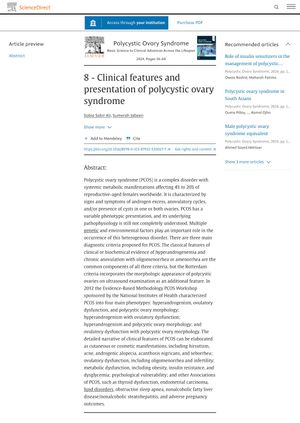Clinical Features and Presentation of Polycystic Ovary Syndrome
April 2023
in “
Elsevier eBooks
”
polycystic ovary syndrome PCOS androgen excess anovulatory cycles ovarian cysts hyperandrogenemia chronic anovulation oligomenorrhea amenorrhea hirsutism acne androgenic alopecia acanthosis nigricans seborrhea insulin resistance dysglycemia thyroid dysfunction endometrial carcinoma lipid disorders obstructive sleep apnea nonalcoholic fatty liver disease nonalcoholic steatohepatitis fatty liver disease

TLDR PCOS is a hormonal disorder causing symptoms like excess hair, acne, irregular periods, and fertility issues.
Polycystic ovary syndrome (PCOS) is a complex disorder affecting 4% to 20% of reproductive-aged females globally. It is characterized by androgen excess, anovulatory cycles, and/or ovarian cysts. The disorder's pathophysiology is not fully understood, but it is believed to be influenced by multiple genetic and environmental factors. PCOS is diagnosed based on three main criteria: clinical or biochemical evidence of hyperandrogenemia, chronic anovulation with oligomenorrhea or amenorrhea, and the Rotterdam criteria also include the morphologic appearance of polycystic ovaries on ultrasound. In 2012, the National Institutes of Health categorized PCOS into four main phenotypes. Clinical features of PCOS include cutaneous or cosmetic manifestations (hirsutism, acne, androgenic alopecia, acanthosis nigricans, seborrhea), ovulatory dysfunction (oligomenorrhea, infertility), metabolic dysfunction (obesity, insulin resistance, dysglycemia), psychological vulnerability, and associations with other conditions like thyroid dysfunction, endometrial carcinoma, lipid disorders, obstructive sleep apnea, nonalcoholic fatty liver disease/nonalcoholic steatohepatitis, and adverse pregnancy outcomes.








